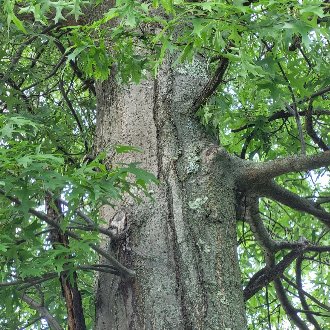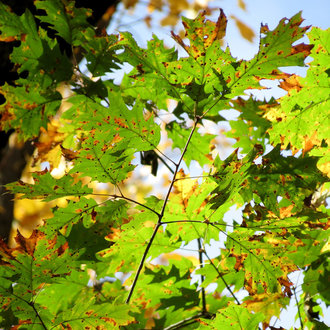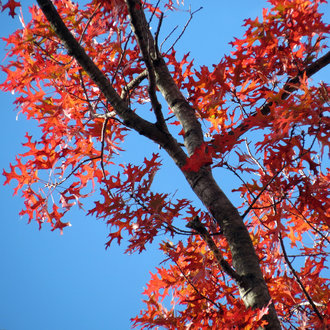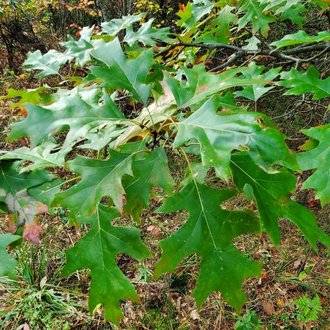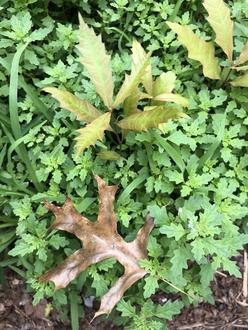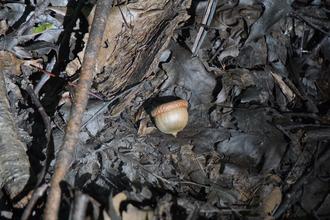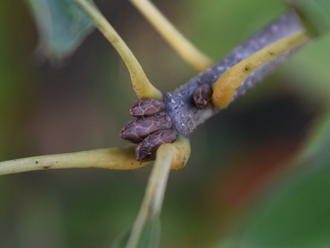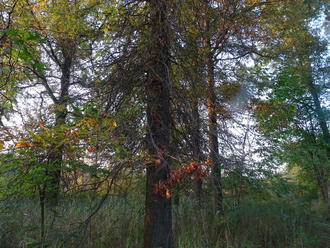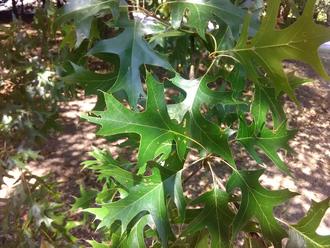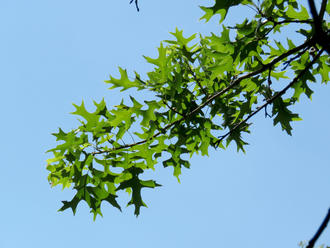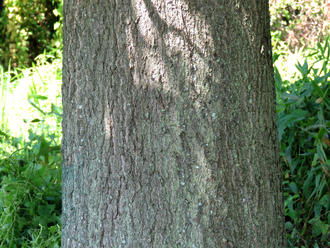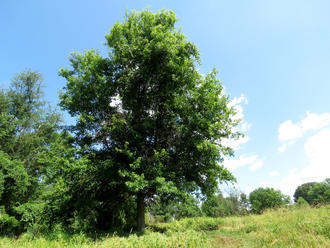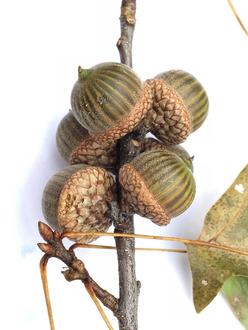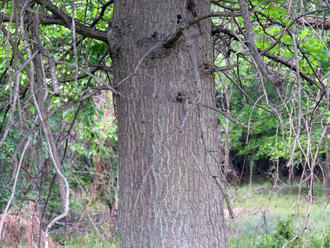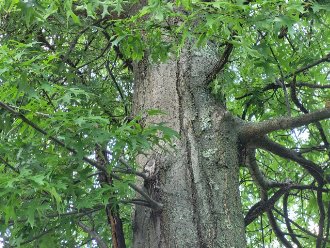Pin Oak (Quercus palustris Münchh.)
↑Summary
A fast-growing, short-lived red oak of poorly-drained sites, with a large, heavy central trunk and numerous small side branches.
↑Range - Expand
| Legend | Color |
| Native | |
| Native or Not Present | |
| Expanded | |
| Native or Expanded |
This tentative map is based on our own research. It may have limited data on Canada and/or Mexico, and there is some subjectivity in our assignment of plants as introduced vs. expanded. Read more in this blog post.
Although this plant occurs somewhere in each of these regions, it may only occur in a small part of some or all of them.
This species is widely planted in landscaping outside its native range, and often escapes. It has established only slightly north of its native range in a few places, which we mark as expanded rather than introduced because they are so close to its native range.
↑Similar Plants
↑Habitat
Pin oak is found mostly on wet, poorly-drained sites with significant direct sunlight, on moderately acidic soils. Natural habitats include forests in floodplains and bottomlands, locally better-drained sites within swamps or around wetland margins, and flat, poorly-drained sites on uplands, such as are common on glacial till plains in the Midwest. Anthropogenic habitats include poorly-drained sites in abandoned fields, wild margins of parks, suburban gardens, and small forest fragments around urban and industrial land.
Pin oak inhabits a relatively narrow climate-zone that stretches farther east-west than north-south, which may partly reflect its pH tolerances, narrower than most plants. It usually occurs on soils with pH between 5.0 and 6.5; we found a few sources saying it can tolerate pH as low as 4.5 or as high as 7, but it is less common and struggles more on such sites. Its intolerance of alkaline soils is likely a factor in its northwestern range limits, whereas highly acidic soils may limit it at the southeastern border of its range.
This oak is often most competitive in clay to clay-loam soil textures, but it can range into loamy or sandy soils on sites where the local hydrology hinders drainage. Ideal soils are poorly-drained but nutrient rich, conditions that often occur in and near low-lying depressions where organic matter accumulates. Pin oak tolerates the sort of soil compaction often found in urban areas, and compaction can sometimes simulate its natural habitats. The sites where pin oak occurs frequently flood during the dormant season, but remain relatively drier during the growing season.
Pin oak is fire-intolerant, and is usually limited to areas that do not burn, although it can sometimes colonize bottomland sites that have burned during a period of extreme drought.
Within floodplains, this species is one of the later colonizers of land, and is often part of the climax community in bottomlands. It can sometimes form pure stands, or can share a habitat with swamp white oak (Quercus bicolor), an oak of the white oak group with similar habitat preferences. In the south of its range, it often shares its habitat with willow oak (Quercus phellos), and, where the species overlap in the Mississppi River Valley, with cherrybark oak (Quercus pagoda). It also often occurs with white oak (Quercus alba), American elm (Ulmus americana), and American sweetgum (Liquidambar styraciflua). It also occurs as a more minor component of many other bottomland forest types where there is a higher diversity of tree cover.
Pin oak is usually not found on newly-deposited land such as sandbars, and instead only colonizes locally better-drained sites in floodplains that usually do not flood quite as frequently or deeply during the growing season. As soil accumulates on a site, pin oak tends to colonize after black willow (Salix nigra), eastern cottonwood (Populus deltoides), and common buttonbush (Cephalanthus occidentalis), and, on sites with sufficient drainage, will replace these species.
Pin oak is usually absent from better-drained sites because it out-competed by more shade-tolerant trees on these sites, such as white oak, American elm, and hickories (Carya sp.)
↑Life Cycle
Pin oak is unusually short-lived and fast-growing among oaks; only water oak (Quercus nigra), another bottomland oak, is shorter-lived.
Acorns germinate in spring, following a period of cold dormancy. Plants initially establish only a root system, with foliage emerging later. Seedlings can use stored energy to survive heavy shade, but will only survive in heavy shade for 2-3 years, after which they die. Seedling establish best when they are shaded in their first year, establish, and then are released to more open light conditions when they already have an established root system. Typically, only seedlings receiving significant direct sunlight from 2-3 years onward are able to survive to maturity. These conditions often occur in gaps or edges in bottomland forests, and can also be found under the lighter shade cast by early-successional trees and shrubs such as willows.
Trees typically begin producing seed at about 20 years of age; trees grown in full sun in otherwise favorable conditions will mature faster and often produce seed as early as 15 years. However, high volume of seed production does not usually start until around age 25-35. Trees usually produce a low volume of acorns in most years, with a large crop in masting years, occuring every 3-4 years on average.
The acorns are primarily distributed by seed-caching animals, including squirrels, mice, blue jays, and woodpeckers. The acorns are smaller than those of most oaks, making birds and smaller mammals relatively more important for this particular species of oak, with blue jays of particular importance, although squirrels remain important as well.
Seeds have a high rate of viability, and are not usually damaged by being submerged in water for long periods of time, which allows this species to reproduce in the habitats where it is often occurred, where winter flooding is common.
Trees usually reach their maximum height and spread at around 80-100 years of age, and live 150-200 years, with a few rare individuals living to 500 years. However, trees in landscaping often die much yonuger, often after 75 years or much less when planted on an unsuitable site or inappropriately pruned.
Since the introduction of oak wilt fungus (Bretziella fagacearum), trees are usually killed by this disease. However, there are also numerous other diseases, including oak leaf blister (Taphrina caerulescens), the fungus Endothia radicalis which causes pin oak blight, the Dothiorella quercina canker, and various bacterial diseases, that affect this species. Diseases that affect all oaks often are more harmful to this species in particular. Pin oak is highly susceptible to mechanical damage or damage from fire; wounds provide a point of entry that can allow disease to infect and eventually kill a tree. On poorly-drained sites, trees without visible damage to aboveground parts may have extensive damage to root systems, caused by growing season floods killing parts of the root system. On better-drained sites, mortality can occur when pin oak is overtopped by other trees, which can occur at any stage of its lifecycle. Most of the trees that inhabit rich mesic deciduous forests are more shade-tolerant than pin oak, and/or reach higher maximum heights.
↑Faunal Associations
Oaks in general support a massive amount of wildlife, and pin oak is no exception.
Numerous animals eat the acorns, and because they are smaller than most oaks, they are of greater importance to birds, including the blue jay, wood duck, mallard, wild turkey, white-breasted nuthatch, tufted titmouse, and the introduced monk parakeet. They were likely important to the extinct passenger pigeon as well. The blue jay is most important to seed distribution as it is most likely to bury them for later consumption, whereas the other birds are more likely to simply eat the acorns without caching them. Ducks rely on the acorns during migration, which tends to coincide with when the acorns come ripe. Mammals that eat the seeds include the fox squirrel, gray squirrel, red squirrel, southern flying Squirrel, White-Footed Mouse, and muskrat.
The leaves and twigs are browsed by white-tailed deer.
Numerous bird species use pin oak as a nesting site. Its tendency to grow next to bodies of water, combined with its dense tangles of lower branches, make it a preferred nesting site for herons, egrets, and other water birds; these birds often form large colonies. Numerous songbirds also nest in it, but without having as strong a preference for this species in particular.
Too many insects rely on oaks to exhaustively list them here. At least 41 species of Lepidoptera (moths and butterflies) have specifically been recorded eating pin oak in their larval form, and far more have been documented on red oaks in general and likely eat this species too. Most of these Lepidoptera do not cause appreciable damage, but the spongy moth (Lymantria dispar), forest tent caterpillar moth (Malacosoma disstria), oak leaftier (Acleris semipurpurana), and the yellow-winged oak leafroller moth (Argyrotaenia quercifoliana) can harm trees, especially if they are already stressed. Other insects able to cause significant damage to this tree include the obscure scale (Melanaspis obscura), the pin oak sawfly (Caliroa lineata), the horned oak gall wasp (Callirhytis cornigera), and the gouty oak gall wasp (Callirhytis quercuspunctata).
Other insects supported by pin oak include long-horned beetles and other beetles that bore into the wood or bark, and leaf beetles and flea beetles that feed on the foliage, many treehoppers that feed on plant juices, several aphids, and other gall wasps. These other insects usually do not cause appreciable harm to trees.
↑Control
There is no evidence pin oak causes any ecological harm anywhere it currently occurs in North America, however, as it has a faster lifecycle than most oaks, it may have invasive potential. It is currently established in the wild in Europe, from Denmark and Germany east to Romania. Another oak of the red oak group, northern red oak (Quercus rubra), has become invasive in Europe.
It is best to avoid planting pin oak on other continents or in areas far removed from its native range and separated by major geographic divides.
↑Uses
Pin oak is widely planted as a landscaping tree, due to its rapid growth, ease of transplanting, single-trunk habit and lack of heavy side-branches, and tolerance to pollution, road salt, and urban conditions. It is, however, not always the best choice of tree for planting around buildings and in urban areas, as it can grow to massive sizes, its rapid growth can necessitate frequent pruning if it is planted on too small a site, and it is short-lived and disease-prone.
In landscaping, pin oaks are often planted without regard to their habitat preferences; although it has some drought tolerance, and can often survive in landscaping on sites drier than where it would occur in the wild, it is not the best choice of oak for a dry hillside. The fact that pin oak has a strong pH preference, combined with the fact that pH is not directly observable, often leads this species to be planted on sites with inappropriate pH; this occurs most often in the north of its range, when it is planted on alkaline soils; such plants often develop chlorosis, which manifests as yellowing leaves. With a relatively large range stretching from Oklahoma to New England, north from Michigan into Mississppi and southern Arkansas, pin oak also has a lot of variability in the adaptations of local populations to differing climate and soil conditions, including soil pH, so, although healthy pin oaks occur in the wild on soils of pH 5.0 to 6.5 and occasionally beyond, individual populations may not be ideally suited to local conditions in another region
A combination of poor site selection with tree planting without regard to sourcing from local populations leads pin oaks to be much shorter-lived in landscaping than they are in the wild. Stressed trees inevitably succumb to disease, usually oak wilt, and may require costly work to remove. The heavy pruning of trees planted in landscaping often increases the spread and severity of oak wilt, as well as other diseases, contributing to pin oaks tending to die early.
Pin oak is one of the best trees, and possibly the best oak, for reclamation of sites where mine spoils have been covered with richer topsoil, typically soil from former agricultural land that was itself also cleared by strip mining. It often colonizes strip-mined lands on its own, but it is also easy to transplant or seed onto a site.
Pin oak, along with other oaks, is frequently planted in green tree reservoirs, managed areas that are artificially flooded in order to create bottomland forest habitat, usually with the intent of increasing the waterfowl population.
Pin oak is also used for timber. The wood is hard, strong, and lower-priced than most wood of similar quality, but its decay resistance is poor, even relative to other red oaks. It is usually combined with other red oaks and sold generically. This species' combination of rapid growth, preference to grow in full sun, and tendency to grow naturally in monocultures on flat sites that are relatively easy to access, makes it ideally suited to repeated clearcutting, which is typically done at 40-year increments. Better-quality wood is used for cabinetry, furniture, flooring, interior trim, and veneer. In areas where it is locally abundant it is also often used for construction. Lower-quality boards are used for pallet stock.
Pin oak lumber is limited by its knottiness and its tendency to suffer from ring shake, which can cause splitting during milling, or failure under load. Knotty growth and ring shake are both more common when random open-grown pin oaks, such as in pastures or landscaping are harvested for lumber; the quality of wood can be better controlled when this species is grown intentionally for lumber.
The wood of pin oak, including from trees unsuitable for use as lumber, is also widely used as firewood. The wood often has an unpleasant smell, typically caused by a bacterial infection, which lingers for a few months, but usually dissipates.
↑Related Plants
Pin oak is probably closest-related to Nuttall's oak (Quercus texana), which is similar both in physical characteristics and habitat preferences, so similar that it was at one point proposed as being a sub-taxon of Quercus palustris. Genetic analysis has reinforced this close relationship. Nuttall's oak largely replaces pin oak in the lower part of the Mississippi alluvial plain, but there is a zone of overlap, mostly in Arkansas and Western Tennessee and slightly north in the region near the Mississippi-Ohio River Confluence. The cultivar 'New Madrid', derived from a wild plant, is thought to be a hybrid of these two parent species. Given that these species have overlapping bloom times and are closely-related, it seems likely that natural hybrids occur with some regularity; it could be that such hybrids are underreported because the difficulty of definitively identifying them.
Aside from Nuttall's oak, pin oak is not particularly closely-related to other red oaks, with these two species originating from a more basal lineage than all but a few species of the red oak group.
That said, all red oaks are closely-related, and this species can and does hybridize with a number of other red oaks with which it overlaps in range, including scarlet oak (Quercus coccinea), shingle oak (Quercus imbricaria) (forming Quercus ×exacta), willow oak (Quercus phellos), northern red oak (Quercus rubra), Shumard's oak (Quercus shumardii), and black oak (Quercus velutina). All of these hybrids have been documented on multiple sites, across long distances, but are relatively uncommon; of them, Quercus ×exacta is most common. The hybrids, however, may be underreported because of the difficulty of oak identification, including the staggering number of different possible hybrids, leaving people to leave most individuals of all but the most common hybrid oaks un-identified.
↑Notes
Pin oak has naturalized north of its native range, forming sustaining wild populations from landscaping escapes; one such population is around Colby College in Waterville, Maine; although there are no records on BONAP, iNaturalist has some other reports in areas beyond those reported by BONAP which may represent populations in the earlier stages of escaping into the wild, such as volunteer saplings surviving multiple years. It will likely expand its range northward in these areas in coming years. There is no evidence that these introductions have caused any harm to ecosystems.
↑Links & External Resources
• Pin Oak | The Wood Database (About This Site)
• Pin Oak | Fire Effects Information System (FEIS) (About This Site)
• Quercus palustris (Pin Oak) | Illinois Wildflowers (About This Site)
• Quercus palustris (Pin Oak) | USDA PLANTS Database (About This Site)
• Quercus palustris | Go Botany (About This Site)
• Quercus palustris (Pin Oak) | Missouri Botanical Garden Plant Finder (About This Site)
• Pin Oak | Virginia Tech Dendrology Factsheets (About This Site)
• Pin Oak | Silvics of North America (About This Site)
• Quercus palustris | Biota of North America Project (BONAP) (About This Site)
• Quercus palustris | NatureServe Explorer (About This Site)
• Quercus palustris | Flora of North America (About This Site)
• Pin Oak | Maryland Biodiversity Project (About This Site)
• Quercus palustris Muenchhausen (Pin Oak) | Digital Atlas of the Virginia Flora (About This Site)



